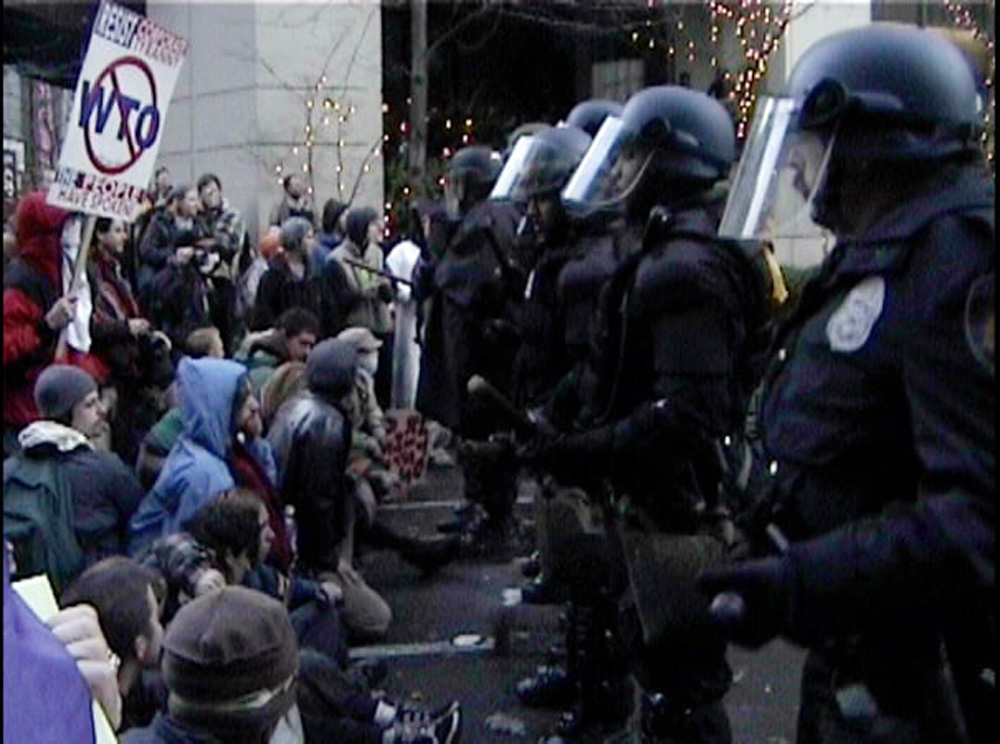Ian Bell wastes little time in tying “WTO ‘99” to the present moment, as an early recap of the debate about the U.S. even entering the World Trade Organization a few years before their annual conference was held on American soil for the first time in 1999 features Bernie Sanders and Trump toadie Roger Stone, then part of a presidential exploratory committee nearly two decades before he decided to run. While there was excitement in the corporate class about the potential for free trade agreements, there was reticence amongst workers who could see their jobs move to where labor was least expensive and environmentalists warned of the perils of greater industrialization in countries with already lax regulations regarding pollution. Still, it was a more innocent time for the world and more immediately for the people headed to the Pacific Northwest to protest, perhaps aware of the kinds of violence that previous generations were greeted with at events like the Democratic National Convention in 1968, but to go by an informal poll taken inside a van in one of the thousands of hours of amateur video that Bell and crew pored through to create a portrait of the infamous four-day affair, police would have no need to pull out the pepper spray or worse when it was expected to be peaceful.
For those who may remember the intensity of the event or simply weren’t born yet, “WTO ‘99” is brings it all back with electricity, but with hindsight, the all-archival time capsule takes on an even greater value as it insists on the need for public pushback when far-reaching policy is conceived behind closed doors and makes clear the factions that are responsible for our current political climate are merely evolutions of what have existed for some time. In one of the film’s moments of schaudenfreude, then-Starbucks CEO Howard Schultz may not have understood at the time why the flagship location on 9th and Pike was targeted – slightly less a behemoth than it is now, but nonetheless recognized by some then for the dangers it could pose for wages and supply chains by any one company dominating the market.
A decision to clear the streets of Seattle using tear gas a mere two hours into a peaceful sit-in for delegates shows whose interests the government wanted to defend in terms of its citizenry or its corporations, but one can also see clearly how two different camps of activists’ differing attitudes towards the best form of protest threatened to stymy potential progress. Although both support for and against the World Trade Organization ran across party lines – U.S. membership was initiated by Reagan and pushed to the finish line by Clinton – quite starkly in Seattle, there is an uneasy convergence of the group of protestors that convene for an AFL-CIO rally in one part of the city, comprised of more rank-and-file union members and traditional political organizations, and those in Union Square that more aggressively put their bodies on the line, most of whom are simply passionate about the cause, but others who are there to really wreak havoc, destroying storefronts and cited by everyone from the local police to President Clinton as justification to take away the right to assemble.
Media reports that reduced everyone on hand to an indistinguishable mass didn’t serve the greater public well, particularly when the reasons people felt compelled to protest didn’t easily align with fixed political persuasions and besides adding some much-needed nuance in terms of identifying their motivation, Bell and co-editor Alex Megaro use the video they have, remarkably at times from both demonstrators and police, to show the reality of what was happening versus how it was presented on the news with footage captured in the same moment by amateurs and professionals alike. Accompanied by the knowledge of how the middle class has been hollowed out and cell phone cameras have become one of the last defenses against police overreach since the turn of the century, the footage feels especially vital in terms of offering a sophisticated view of where we are now. Although it can almost seems like a great punchline to a cosmic joke to learn at the end that the director of the WTO at the time was named Mike Moore when the other Michael Moore, who directed “Roger and Me,” is outside shouting about the horrors of globalization when all this saber rattling can come across as white noise to simply ignore, “WTO ‘99” becomes undeniable in how it illuminates the prescience of what was once dismissed in the mainstream as a radical fringe and the perils of disengaging from political discourse.
“WTO 99” will screen again at True/False on March 2nd at 8:45 pm at the Blue Note.




